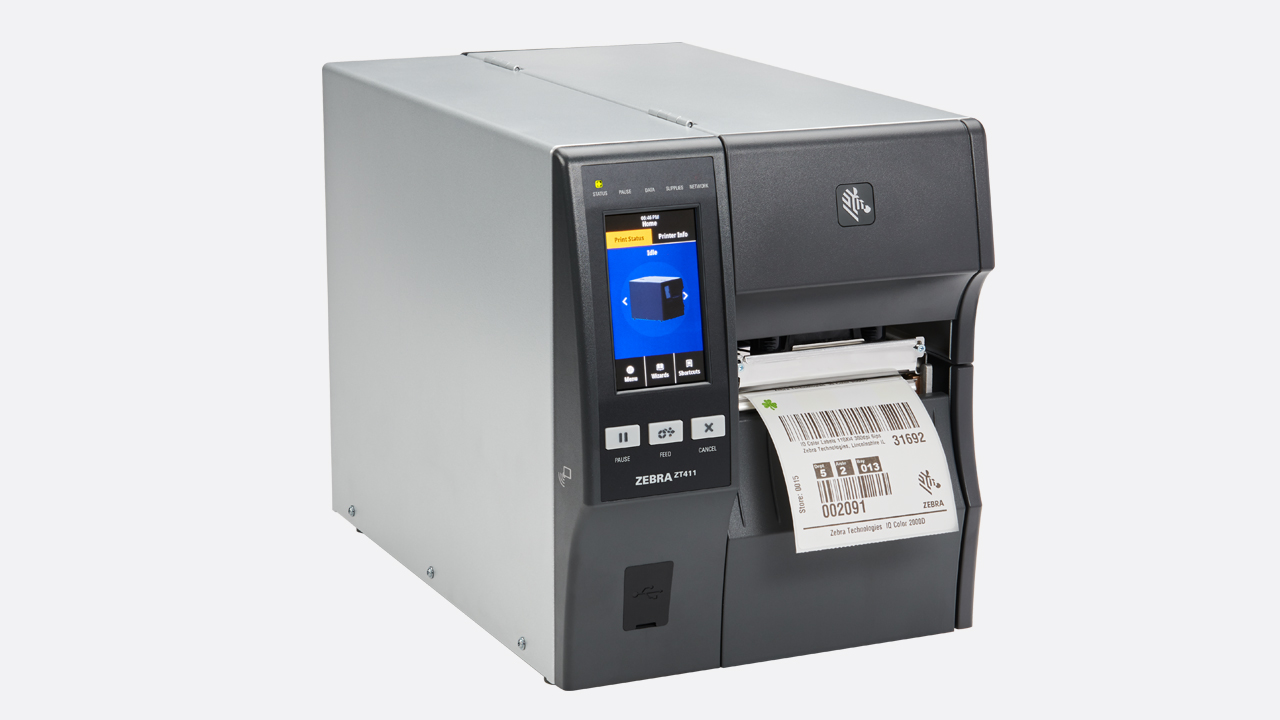
More Than Just a Face Lift: Zebra ZT400-Series Industrial Printers Receive Game-Changing Upgrades
Printers aren’t the first thing that come to mind for most people when talking about technology modernization, much less rugged-to-the-core industrial printers. Yet, printers play a very critical role in modern technology architectures, especially in warehouses, factories and other facilities that tend to be the epicenters of “operational modernization” for supply chain organizations these days.
Between the eCommerce boom and the Industry 4.0 movement, we’re seeing a push-pull effect between our customers (i.e. you) and their customers to produce, pick, pack and ship products of all shapes, sizes and volumes at speeds that even Amazon-sized operations are challenged to sustain. That means that every part used to manufacture those products and every finished product need to be quickly tagged as it moves along the assembly line. Oh, and all of these actions need to be done with complete accuracy. No big deal.
Except it is.
That is why printers – and efforts put forth to modernize printers – are still a big deal. To you, to Zebra and (whether they realize it or not) to your customers.
Printers Make a Very Real Mark on Your Products and, Therefore, Your Supply Chain Performance
Fulfillment speed and accuracy is determined by many different factors. Among them: the proper marking of assets at the point of origination, and occasionally at transfer points, so that they can easily be traced as they make their way from the manufacturing facility to the end-customer – and for years after they are entered into service.
Remember, a single-produced good such as a refrigerator could have multiple parts, all of which require a unique label that must remain readable for the life of the product for warranty and service purposes. And labels printed for package shipping or the management of healthcare assets such as wheelchairs must be able to withstand the extreme environmental, chemical and even machine-based elements with which they’ll come into contact.
While your workers may be the ones responsible for making sure a product is properly marked before it is stored or shipped to the next recipient, it is on you to ensure they have a way to print clean, accurate labels that will remain readable for life, whether by scanners or the human eye.
That’s a big responsibility to bear, which is why Zebra feels such a tremendous responsibility to continuously modernize its printing technologies. We want to make sure that your printing systems will produce quality labels and tabs every time you submit a print job – and that you will maximize your return on investment (ROI) in Zebra printing solutions. Your printer is a fundamental enabler of your order fulfillment capabilities. (It also influences your inventory management, loss prevention, quality assurance and customer satisfaction success rates!) Therefore, we are committed to help ensure your printing solution will fulfill your tremendous workflow demands without issue. Or, as we like to say, make your printing-dependent workflows less demanding on your workers and wallet.
With that in mind, it is my honor to announce that we’ve made some significant enhancements to our ZT400-series industrial printers!
We know the ZT400-series printers have been customer favorites for the last five years, especially among manufacturers, warehouse operators and healthcare providers who need a rugged and secure industrial printer that can bulk print 4-inch and 6-inch labels for a number of different applications. You may even be printing thousands of high-quality labels on a ZT400-series printer in your facility today and, thus, wondering why in the world you would want or need to upgrade to the ZT411 or ZT421 right now.
Simply put, we want to ensure that you’re just as happy with the output of your ZT400-series printing solution in five (or 10) years as you are today – whether you’re opting to upgrade to one of these new models today or two years from now. Our hope is that each of the printers’ improvements will translate into operational improvements for you!
Meet the New Zebra ZT411 and ZT421 Industrial Printers
As you will see below, we have built the new-generation ZT411 and ZT421 models to better evolve with your business. We have also added some tools to further improve the speed, accuracy and quality of your current printing applications. Specifically, we wanted to ensure these new printers would…
1. Continue to stand the test of time. Some people may wonder why we would want to “future proof” our printers. Why make them last longer? Doesn’t a shorter lifecycle and, therefore, more churn benefit Zebra? Other solution providers may feel that way; we don’t. We want you to extract as much value from your investment as you can, for as long as you can. And the last thing we want to do is disrupt your business. That’s just bad business for us. So, we’ve made the printers even more adaptable to your evolving business needs.
How? By expanding their factory or field-upgradeability. At some point, you may need to start marking metal assets with RFID-readable tags. You just won’t need to spend money on a completely new printer to do so.
With the new ZT411 and ZT421 models, you can add on Zebra’s RFID On-metal Tagging Solution if you ever need to print and encode thicker UHF RFID tags with effective read range – after the printers are already up and running in your environment. You don’t need to send them back to a Zebra service center to make this change.
And, like the previous generation of ZT400-series printers, you can also expand your printer’s connectivity options as your workflow demands expand by adding an applicator interface card, dual band 802.11ac Wi-Fi® with Bluetooth® 4.1, Parallel and/or Ethernet.
2. Reduce “standby” time. Printers can be a big source of operational downtime. Batches of poor quality (i.e. unreadable) labels can force reprints. Improper setting configurations during media type transitions can lead to long troubleshooting processes. Dim facility lighting, and no lighting inside the media compartments, can make it difficult to see if media is being loaded properly. All of which can completely stop movement on an assembly or packing line and lead to expensive fulfillment delays or slow down the introduction or inventory of critical healthcare equipment that really need to be put into service STAT. So, we designed the ZT411 and ZT421 to reduce the length of time workers have to “stand by” the printer to submit a print job, adjust settings, troubleshoot a problem or change out media – things that could put your whole operation on standby waiting for a label.
How? By adding several tools that reduce the time spent submitting print jobs, offer “fast fix” recommendations and aim to pre-empt troublesome errors so you can bypass the troubleshooting process all together. These include:
- Dual USB host ports. Workers can now plug in a memory stick or scanner and a keyboard at the same time! Believe me, this is big! The seconds saved by not having to repeatedly swap out peripherals to upload files or input label data – and the minutes saved by not having to walk to a desktop station to submit a print job – can make a big difference on your fulfillment rate and bottom line.
- A color touchscreen that will turn your workers into self-sufficient print managers. Thanks to the vibrant printer display and video-guided “wizard” experience, your workers won’t need to submit IT tickets or complete special training to setup the printer to handle a new media, troubleshoot an error code or retrieve and complete a print job submitted from another computer. Clear, concise instructions will be right there on the color touchscreen via text and animation. Your team will even be able to set up shortcuts for common applications and configurations. (Note: I don’t usually advocate for anyone to take shortcuts in business. But, if your workers are constantly switching printer settings and you don’t want them to screw anything up, then the ability to set up shortcuts is a huge benefit.)
- “Printhead element out” detection. You know those labels that have white lines cutting through the barcode, address and other critical information? The ones you have to regretfully throw away and reprint? Those are the result of a failed printhead element. That’s why we’ve added a remote alert system to the ZT411 and ZT421 printers that will give you a heads up when the printhead element is out. You’ll be able to replace the printhead before printing batches of bad labels. (The same alert will also be on the color touchscreen until addressed, so there’s no risk of a missed alert.)
- Bluetooth – The ZT411 and ZT421 give workers the option to submit a print job from near or far, via multiple data source devices. This is where that wireless connectivity upgrade may come in handy.
Check out this video to see some of these new features in action*:
*Note: this video shows the ZT610, but the same features are now available on the ZT400-series printers.
Of course, you can find more details about the cool new capabilities of the ZT400-series industrial printers on our website. Or, you can drop us a note if you’d like to set up a demo or just figure out whether or not the ZT411 or ZT421 is the right printing solution for your current and planned printing applications.
After all, that’s what really matters…making sure you have the right printing solution for your labeling applications, especially as those labeling applications evolve or expand. As I said before, and will most definitely say again, the performance of your printer has a big impact on the performance of your business. That means that investing in a printer that will consistently produce labels that meet your quality standards, and that enable your employees to meet your productivity standards, should be a business priority.

Eric Nudel
Eric Nudel is currently a Senior Product Manager in the Specialty Printing Group where he is responsible for developing Zebra’s stationary thermal printer product offerings and driving the development, launch, and adoption of product updates, new products, and adjacent technology products.
Mr. Nudel has more than 10 years of experience within the thermal printing industry at Zebra, previously serving as a Firmware & Software engineer on Zebra’s Development Services team.
He holds a B.S. in Computer Engineering from the University of Illinois at Urbana-Champaign.




